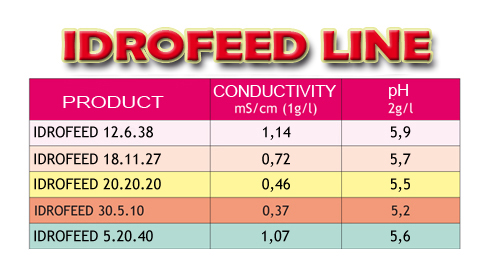Technical informations
Foliar Fertilization
Foliar fertilization is an agronomic technique that only in the last years found a widespread application by farmers. Ease use, a quick fertilization and good results make this technique more and more applied by farmers.
A correct foliar fertilization must have the following aims:
– To apply high quality products;
– To provide elements as and when the plants really need them;
– To carry out treatments at the right stages and at the right hours of the day.
The more appropriate hours of the day to carry out foliar fertilization are: early in the morning and late in the evening when humidity in the air is higher. Early in the morning and late in the evening in fact stomata of leaves are opener and the distributed water slowly dries up allowing a better absorption of the product.
The quantity of water suggested per hectar for every application, according to treated crop is the following one:
Fruiting plants, actinidia and vine 10 - 15 hl/hectar
Citrus 15 - 20 hl/hectar
Horticultural, strawberry, melon and water melon 6 - 9 hl/hectar
Floricultural 6 - 7 hl/hectar
Nursery and lawns 8 - 10 hl/hectar
Industrial, arboreal and cereal crops 5 - 6 hl/hectar
In this way it will be easier to calculate the correct dosage for each fertilizer per hectar: dose per hl of water multiplied by recommended hectolitres.
Fertirrigation
Fertirrigation is an agronomic technique of recent introduction in agriculture, which consists in fertilizing and watering at the same time and together and is thus the most efficient method for satisfying the plants’ water and nutritional requirements.
This is for carrying out fertirrigation using an irrigation system which is designed to do the job, i.e. equipped with a hose, drip bar, drip system, inferior sprayers, etc., or to do so using mechanical systems applied to a tractor, i.e. a plow, or sidebars with spray nozzles.
In floriculture and horticulture this technique is used by farmers since a long time, in fruiting growing it started to be considered only in the last years, leading to benefits in both the nutrition and production of the plant or crop.
Fertiirrigation can completely substitute the traditional fertilization with a series of advantages:
1) Smaller concentrations of fertilizer are applied and delivered at a rate that can be readily absorbed by plants, there is less of it available for pollution from runoff;
2) Possibility of deliver to plants the elements they really need in the most important stages of the vegetative cycle;
3) Less waste of time: fertilizing and watering at the same time;
4) Less crushing of the soil underfoot;
5) Quicker absorption of nutritive elements;
6) This technique is environmentally friendly: a smaller amount of product is needed by fertirrigation instead of a traditional fertilization.
Soil pH
IT IS IMPORTANT TO KNOW THE PH VALUE OF YOUR SOIL IN ORDER TO OBTAIN GOOD RESULTS.

The effect of soil pH on the availability of essential plant elements.
Conductivity and Ph of the soluble powder fertilizers
Attention: Calculation of the above mentioned values was carried out with distilled water at a temperature of 20 degrees centigrade.


